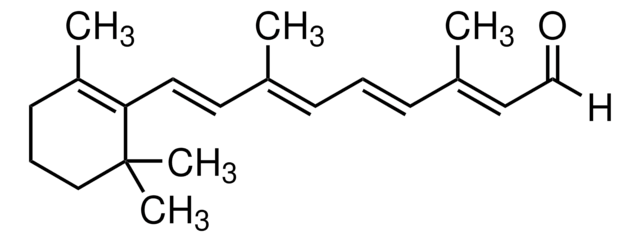R5754
9-cis-Retinal
vitamin A analog
Sinónimos:
Vitamin A aldehyde
About This Item
Productos recomendados
Quality Level
assay
≥95% (HPLC)
form
powder
technique(s)
HPLC: suitable
color
yellow to yellow-orange
mp
56-58 °C (lit.)
shipped in
dry ice
storage temp.
−20°C
SMILES string
CC(=C\C=O)/C=C/C=C(C)\C=C\C1=C(C)CCCC1(C)C
InChI
1S/C20H28O/c1-16(8-6-9-17(2)13-15-21)11-12-19-18(3)10-7-14-20(19,4)5/h6,8-9,11-13,15H,7,10,14H2,1-5H3/b9-6+,12-11+,16-8-,17-13+
InChI key
NCYCYZXNIZJOKI-MKOSUFFBSA-N
¿Está buscando productos similares? Visita Guía de comparación de productos
Application
Biochem/physiol Actions
9-cis retinal is a natural ligand (chromophore) of the vertebrate rod visual pigment. 9-cis retinal is used in studies on the mechanisms of visual function.
signalword
Warning
hcodes
Hazard Classifications
Acute Tox. 4 Dermal - Acute Tox. 4 Inhalation - Acute Tox. 4 Oral - Skin Irrit. 2
Storage Class
11 - Combustible Solids
wgk_germany
WGK 3
flash_point_f
Not applicable
flash_point_c
Not applicable
ppe
dust mask type N95 (US), Eyeshields, Gloves
Certificados de análisis (COA)
Busque Certificados de análisis (COA) introduciendo el número de lote del producto. Los números de lote se encuentran en la etiqueta del producto después de las palabras «Lot» o «Batch»
¿Ya tiene este producto?
Encuentre la documentación para los productos que ha comprado recientemente en la Biblioteca de documentos.
Los clientes también vieron
Artículos
All-trans retinoic acid (RA, ATRA) is a pleiotropic activation factor that regulates genes associated with normal vertebrate cellular processes such as cell differentiation, cell proliferation, apoptosis, and embryonic development.
Nuestro equipo de científicos tiene experiencia en todas las áreas de investigación: Ciencias de la vida, Ciencia de los materiales, Síntesis química, Cromatografía, Analítica y muchas otras.
Póngase en contacto con el Servicio técnico











